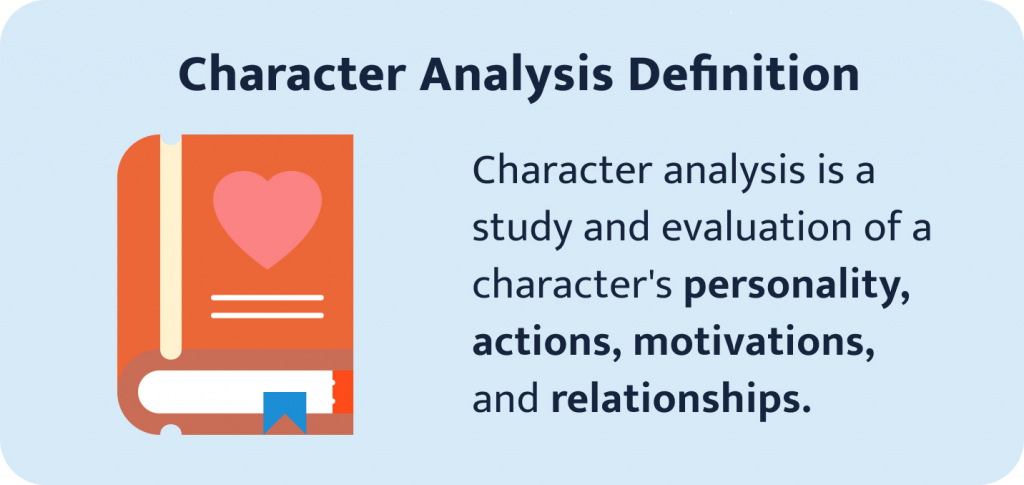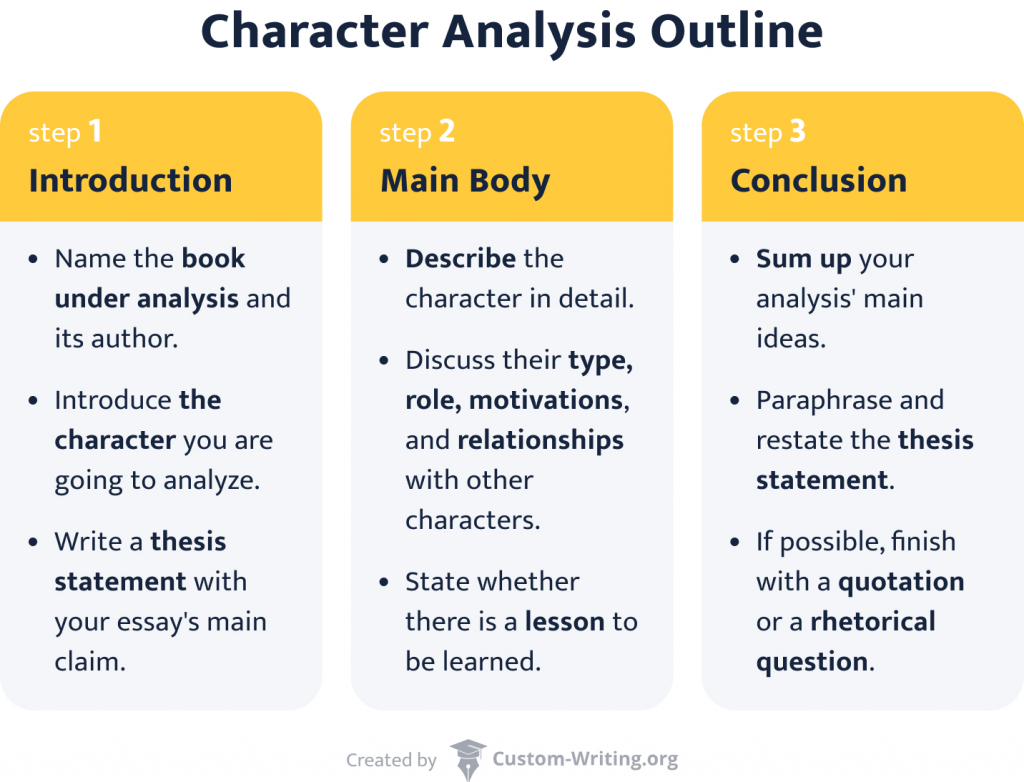
A character analysis is an examination of the personalities and actions of protagonists and antagonists that make up a story. It discusses their role in the story, evaluates their traits, and looks at their conflicts and experiences. You might need to write this assignment in school or college. Like any other essay, your character analysis should contain an introduction, a conclusion, and a thesis.
Our specialists will write a custom essay specially for you!Want to know how to write a character analysis essay? Not sure how to start? We understand. Whichever piece you choose – Lady Macbeth, A Rose for Emily, or something else, – analyzing a character for the first time might be challenging. No worries, we are here to help! In this guide by our custom writing experts, you will find a step-by-step guide, outlining and writing tips, as well as a number of character analysis examples.
A character analysis essay is an assignment where you evaluate a character’s traits, behaviors, and motivations. It requires critical thinking and attention to detail. Unlike descriptions, analyses focus on a character’s personality and internal drives. It explains how those factors shape the narrated events.
Just in 1 hour! Just in 1 hour! Our expert We will write you a plagiarism-free paper in less than 1 hour
Learn More
So, what you need to do is to see the characters as if they were real people who feel and act just as we do. Ensure there are no baseless assumptions and interpretations: the ideas you present should be supported by quotes from the text.
How do you define a character? It is a person, a creature, or an animal that makes up the story’s world. A character can be based on a real-life person, or it can be entirely fictional. It is someone who thinks, feels, and acts.
We use the word “character” in many different contexts. For instance, it can denote someone eccentric or worthy of our admiration. In both contexts, the term “character” means a distinctive personality. Similarly, in an analysis, your task is to show what makes a character stand out.
Characterization is the process by which a character’s personality is revealed. It presents characters’ traits, feelings, and motives to the reader. For this reason, characterization is closely connected to character analysis. It helps us to understand the characters better throughout the reading process.
Get Receive a plagiarism-free paper tailored to your instructions. Cut 15 % off your first order!Characterization can be direct and indirect.
Here are some examples of direct characterization taken from Patti Smith’s Just Kids:
“But he always suppressed his real feelings, mimicking the stoic nature of his father.”
Here we see a direct description of a character. The author straightforwardly talks about Robert’s feelings. In comparison, look at the description of a woman taken from John Steinbeck’s The Snake:
“He looked around at her again. Her dark eyes seemed veiled with dust. She looked without expression at the cat’s open throat.”
These lines don’t directly reveal anything about the woman, but the reader can understand that she is cold and dangerous. It’s an indirect characterization that focuses on looks and actions to convey the message to the reader.
When it comes to characters, they can be divided into several groups. For example, characters can be:
These types define how much the characters change through the course of the story and their role in it.
Get a custom-written paper according to your instructions!In psychology, a character type is defined by a combination of personality traits that coexist in an individual. Authors incorporate different types of characters into their works to convey the message and make the story more exciting or relatable to the reader.
There are three ways to categorize a character type:
If you are about to write a character analysis essay, being familiar with character archetypes is essential. They have been categorized by a generation of writers, including the Swiss psychologist Carl Jung and the American literary theorist Joseph Campbell. A lot of characters we see in today’s literary works are rooted in them.
Archetypes include the Trickster, the Ruler, the Lover, the Sage, and others. The Hero is one of the most notable archetypes. Hercules or Achilles can be good examples of heroic protagonists. They are strong and courageous; they meet challenges and save the day by helping others.
The main character and the protagonist often get mixed up. Most narratives also have the figure of the antagonist, whose actions affect the plot and stimulate change. Let’s have a look at the similarities and differences between these types.
The main character is central in the narrative. We experience the story through their eyes. They don’t necessarily have to be protagonists, though it happens in many cases.
The crucial difference between the main character and the protagonist is that the protagonist goes through changes throughout the story. The main character, however, is there to guide the reader through the experience. Often they help to show a different, darker side of the protagonist.
To understand the difference better, let’s turn to some examples.

In the following sections, we’ll discuss each step in detail.
The beginning of your essay is its crucial part. It sets the mood and grabs the reader’s attention. There are many different ways to write a character analysis introduction, but here are the most effective ones:
The final part of an introduction is a thesis statement.Read on to learn how to write one!
A thesis is the key component of every essay, and character analysis is not an exception. It’s crucial to develop a good and clear thesis statement that includes all the aspects of your paper. For instance, if you plan to write a 4-paragraph body, including 4 points in your thesis.
What should a character analysis thesis include? Well, try to think of any trait that the character possesses that has to do with their downfall or somehow influences the story. Think about how this trait affects the character’s relationship with others or how it contributes to their motive or aspiration.
Take a look at the following examples:
| Thesis Example | Explanation | |
|---|---|---|
| ❌ | Oedipus Rex is prideful, and he searches for the truth; he is also a character that experiences the downfall towards the end of the play. | It’s a weak thesis statement. This sentence doesn’t make the connection between the character’s traits and the outcome. It also contains unnecessary information about the end of the play. |
| ✔️ | Oedipus Rex is a man of pride who persistently seeks the truth, and in the end, it is his pride and the truth that determine his downfall. | This is a strong thesis statement. It explains that the character has two main traits: he is prideful and seeks the truth. It then states that these qualities are the reason for his downfall. |
The main body of your essay can include as many paragraphs as you need. In this part, you introduce the character and analyze them. We have already talked in this article about what kind of questions should be answered in these paragraphs. The most important points are:
Keep in mind that every paragraph should have a topic sentence that captures its main idea.
Tsukuru Tazaki’s spiritual rebirth also affects his physical appearance.
The conclusion part of your essay summarizes all the information you have mentioned and restates the thesis. Here is some advice for your conclusion paragraph:
Most college assignments and essays are written according to the APA or MLA format. Both styles have the same formatting, which requires:
While writing an essay on characters, pay special attention to quotations. Here are some tips for APA in-text citations:
As for MLA format:
Below you’ll find a collection of character analysis essay examples and a downloadable sample to inspire you even more.
Roald Dahl’s Matilda is one of the most famous children’s novels of the 20th century. The protagonist of this tale is Matilda Wormwood, a five and a half-year-old girl with a brilliant and lively mind that distances her from the rest of the family. Matilda’s character is particularly interesting as she has a powerful personality with extraordinary mental abilities, and she manages to overcome all the obstacles that surround her.
Character Analysis of Matilda Wormwood from Roald Dahl's MatildaNow you know everything necessary for writing an excellent character analysis. What character would you like to analyze? Let us know in the comments!
Further reading:
A character analysis involves:
1. description of a character;
2. explanation of how they change throughout the story;
3. their role in the narrative;
4. relationships with other characters;
5. what idea the author wanted to convey through the character.
A character analysis creates a description that contains their most important qualities. It provides a new perspective of a character that reveals more about what it’s like to be human. It can also point to a moral or a lesson.
Tracing the development of a literary character is an example of what type of essay?Literary analysis uses the technique of tracing the character development. This technique is usually used to understand the theme of the work better. Through tracing a character’s development, we can learn more about the story’s message and how it’s conveyed.
What should a summary paragraph in a character study include?A summary paragraph in a character study should include answers to the questions “what,” “who,” “where,” and “why.” You should mention who narrates the story, where the story is set, its theme, and the message it conveys.
This article was developed by the editorial team of Custom-Writing.org, a professional writing service with 3-hour delivery.
Recommended for You ![Critical Writing: Examples & Brilliant Tips [2024]](https://custom-writing.org/blog/wp-content/uploads/2021/02/fingers-note-report-journalist-filling-284x153.jpg)
Any critique is nothing more than critical analysis, and the word “analysis” does not have a negative meaning. Critical writing relies on objective evaluations of or a response to an author’s creation. As such, they can be either positive or negative, as the work deserves. To write a critique, you.

If you are assigned to write a rhetorical analysis essay, you have one significant advantage. You can choose a text from an almost infinite number of resources. The most important thing is that you analyze the statement addressed to an audience. The task of a rhetorical analysis essay is to.

Any literary analysis is a challenging task since literature includes many elements that can be interpreted differently. However, a stylistic analysis of all the figurative language the poets use may seem even harder. You may never realize what the author actually meant and how to comment on it! While analyzing.

As a student, you may be asked to write a book review. Unlike an argumentative essay, a book review is an opportunity to convey the central theme of a story while offering a new perspective on the author’s ideas. Knowing how to create a well-organized and coherent review, however, is.

The difference between an argumentative and persuasive essay isn’t always clear. If you’re struggling with either style for your next assignment, don’t worry. The following will clarify everything you need to know so you can write with confidence. First, we define the primary objectives of argumentative vs. persuasive writing. We.

You don’t need to be a nerd to understand the general idea behind cause and effect essays. Let’s see! If you skip a meal, you get hungry. And if you write an essay about it, your goal is achieved! However, following multiple rules of academic writing can be a tough.
![How to Write an Argumentative Essay: 101 Guide [+ Examples]](https://custom-writing.org/blog/wp-content/uploads/2021/01/young-writer-taking-notes-284x153.jpg)
An argumentative essay is a genre of academic writing that investigates different sides of a particular issue. Its central purpose is to inform the readers rather than expressively persuade them. Thus, it is crucial to differentiate between argumentative and persuasive essays. While composing an argumentative essay, the students have to.
![How to Title an Essay: Guide with Creative Examples [2024]](https://custom-writing.org/blog/wp-content/uploads/2021/01/close-up-woman-making-greeting-card-new-year-christmas-2021-friends-family-scrap-booking-diy-writing-letter-with-best-wishes-design-her-homemade-card-holidays-celebration-284x153.jpg)
It’s not a secret that the reader notices an essay title first. No catchy hook or colorful examples attract more attention from a quick glance. Composing a creative title for your essay is essential if you strive to succeed, as it: Thus, how you name your paper is of the.

The conclusion is the last paragraph in your paper that draws the ideas and reasoning together. However, its purpose does not end there. A definite essay conclusion accomplishes several goals: Therefore, a conclusion usually consists of: Our experts prepared this guide, where you will find great tips on how to.
![How to Write a Good Introduction: Examples & Tips [2024 Upd.]](https://custom-writing.org/blog/wp-content/uploads/2021/01/closeup-shot-woman-working-studying-from-home-with-red-coffee-cup-nearby-284x153.jpg)
A five-paragraph essay is one of the most common academic assignments a student may face. It has a well-defined structure: an introduction, three body paragraphs, and a conclusion. Writing an introduction can be the most challenging part of the entire piece. It aims to introduce the main ideas and present.

Exemplification essays, also called illustration essays, are one of the easiest papers to write. However, even the simplest tasks require experience and practice. It is a good idea to find and analyze free exemplification essay examples. You can also ask your teacher to give you some sample exemplification essays from.
![How to Write about a Topic You Lack Interest in [2024]](https://custom-writing.org/blog/wp-content/uploads/2021/01/Frustrated-exhausted-young-woman-blogger-284x153.jpg)
During their school years, students may not always have the opportunity to select a topic for their essay or research paper. Instructors tend to assign one or offer a list of ideas that might not seem engaging. Moreover, even the topic that you choose yourself can sometimes end up being.